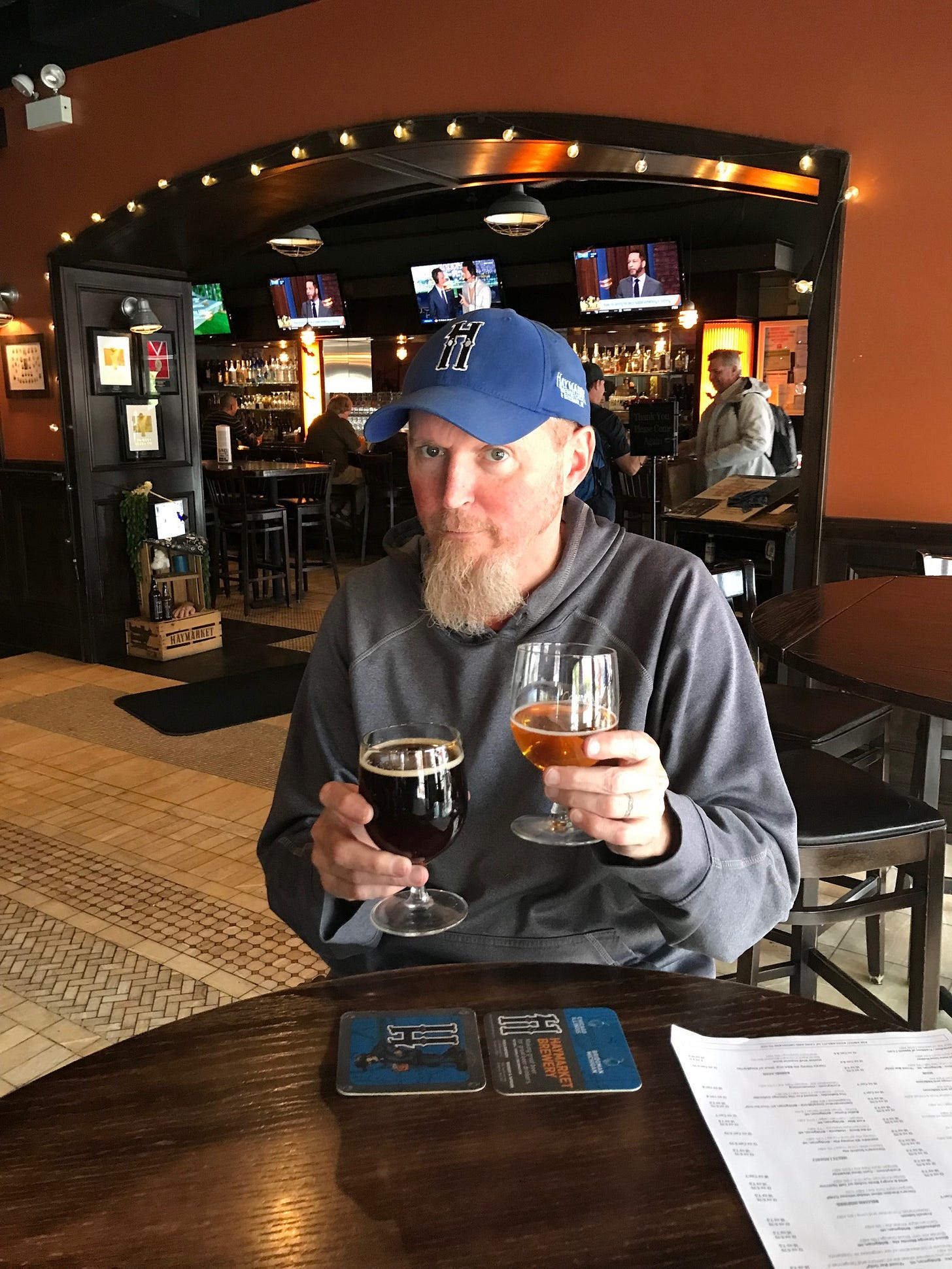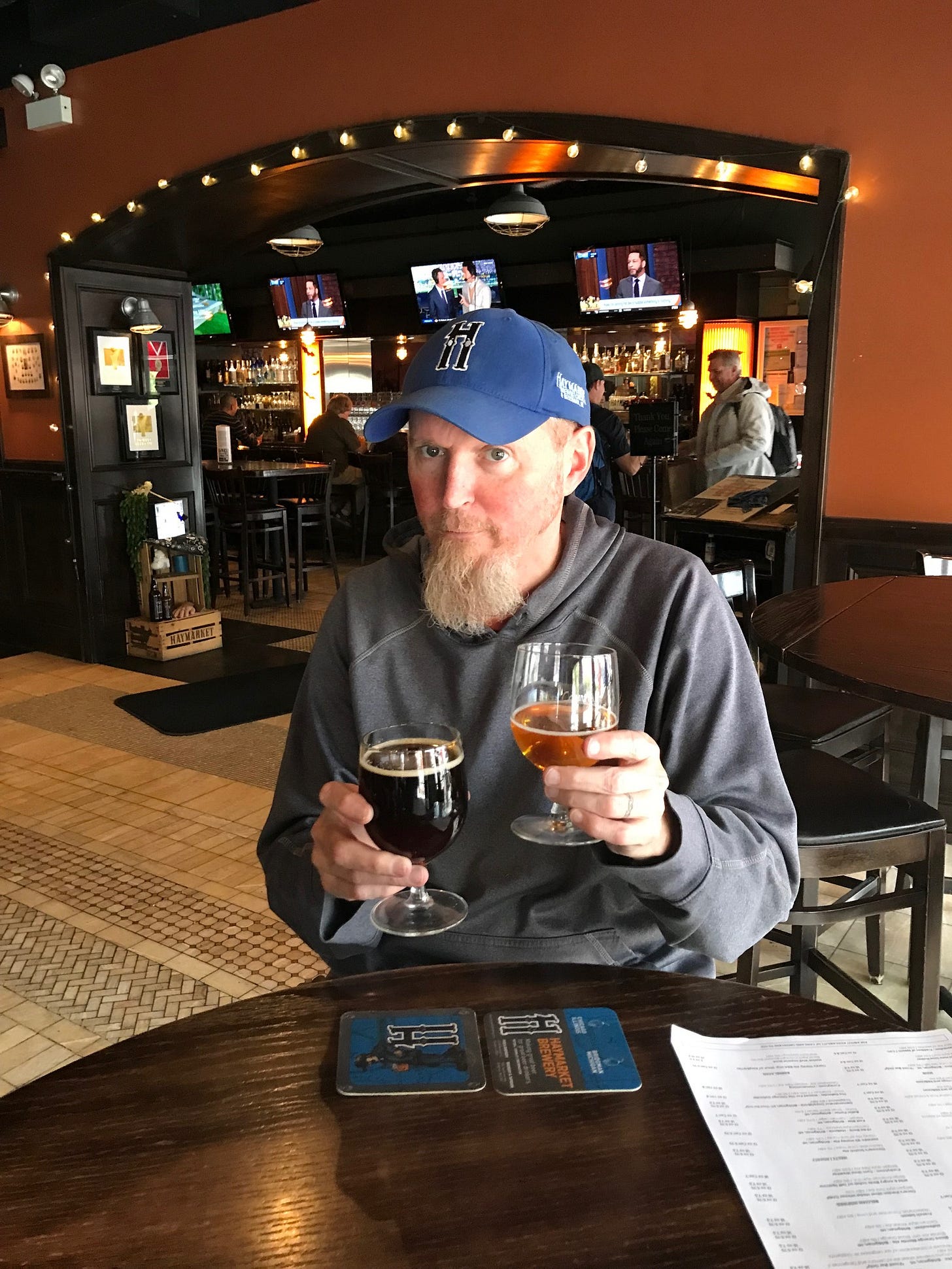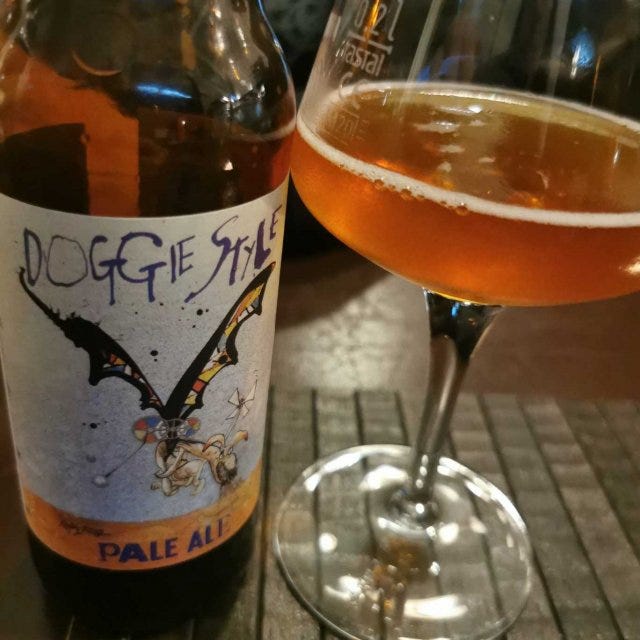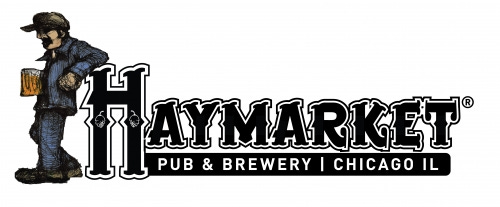This will be the 22nd annual Festival of Wood and Barrel-Aged Beer. The Beer Hunters, Dan Jr. and Dan Sr. will be attending as they did last year. The best Barrel and Wood aged Beer, Cider and Mead will be featured. It began with just barrel aged beers. So lets start with a little Barrel Aged Beer History.
WHERE IT BEGAN
You would get few arguments from craft brewers and beer drinkers that Chicago is the epicenter of of Bourbon Barrel Aged beer. While this style is now served across the country and is a special favorite of craft beer drinkers, Chicago is its center and most likely it’s place of origin.
The origin of making a beer in a bourbon barrel for the first time may be impossible to determine, but I will try.
The year it all began seems to be 1992. Greg Hall the master brewer at Goose Island Brewery had heard that Larry Bell, brewer, founder and owner of Bell’s brewery celebrated making his 1000th batch of beer by making an unusually strong ale in a very limited batch, making it hard to get (starting a tradition carried on to this day in the craft brewing industry). Goose Island was getting close to making their 1000th batch, so Greg was thinking about what kind of unusual or unique beer he could make for this special milestone.
Two events happened in 1992 and I am not sure which occurred first, but I am sure both influenced Greg’s choice of beer for his 1000th batch. One of the events was Greg was attending a dinner at LaSalle’s restaurant in South Bend with industry representatives from top cigar, bourbon and beer companies. Master bourbon maker Booker Noe from Jim Beam was quite a character and a good speaker and he talked of the magic of oak barrel bourbon. This caught Greg’s attention and got the wheels spinning.
The other event was at a 1991 or 1992 Chicago Beer Society (CBS) meeting one of the members, Jim Kubee, brought in an Imperial Stout he had put in a barrel and shared it, as members did at their monthly meeting. Several other members loved the beer so much they convinced Jim to drive down to Jim Beam to see if he could get some Bourbon Barrels. He did and he setup in his house to brew a batch with other members, In the end only a few brewed it with him, (one being Greg Fischer of Bev Art and Brewing supply who went on to supplying a barrel of Bourbon Barrel Aged Stout in front of his store on 101st Western every year at the south side St Patricks Day parade and become one of the first mead makers to put mead in a bourbon barrel) but after 3 months of aging it was ready as a far as they knew. They had a party in Fall and served that Imperial Stout they had aged in that Jim Beam barrel at a Chicago Beer Society dinner held at Goose Island and it was a massive hit. Many brewers attended the dinner, though not certain most said Greg Hall attended.
In the end Greg Hall also got a few Jim Beam barrels and he brewed his 1000th batch, an Imperial Stout aged in that Jim Beam barrel. I am not sure how many batched he made between then and 1995 but what is a fact is Bourbon Barrel Aged beer first public appearance was at the 1995 Great American Beer Festival. Greg Hall brought his Bourbon County Brand Stout to the festival, but it did not fit into any style category at the time, so it was disqualified by the judges.
But the lines for sampling the beer were so long, Hall received so much positive feedback and so many of the best brewers were so impressed with Bourbon County, the judges gave it an Honorable Mention award.
Bourbon barrel aged beer was now on the craft brewer map and several other Chicago brewers began to experiment with this new technique of aging a beer in a used Bourbon barrel. The Big Three were:
Greg Hall
Pete Crowley
Todd Ashman
The first brewer from Chicago to submit a Bourbon Barrel Aged beer to the Great American Beer Festival was Todd Ashman in 1998. Luckily GABF had learned from the 1995 submission of Bourbon County getting disqualified because it did not fit any style category and they created an Experimental category for beers that did not fit their categories. Todd submitted Imperial Eclipse Stout which he had aged in a Jim Beam barrel for 6 months and won a Gold medal in the Experimental category. Todd and Pete Crowley worked with GABF to help them understand these new beer styles and GABF created a Wood and Barrel Aged Category in 2002. In that year Pete won a gold medal in the Wood and Barrel Aged Category for his Terminal Bourbon Stout and Todd won a Bronze medal for his Old Conundrum Barley Wine.
Now Wood and Barrel Aged beer were here to stay, and many of the craft beer pioneers in Chicago thought it was time to start a beer festival devoted to Wood and Barrel Aged Beer. Pete Crowley was the right man for the job. See my interview with Pete to get the details on the creation of FOBAB (Festival of Wood and Barrel Aged Beer)
THE MAN WHO STARTED IT ALL - PETE CROWLEY
I first met Pete Crowley at the 2nd Anniversary celebration for Haymarket Brewery in January of 2012. He seemed very thoughtful, friendly, had a great sense of humor and had five unbelievable Barrel Aged beers on tap to celebrate the anniversary. Over the years he has made some of the best beers I have ever had - including some of the best bourbon barrel aged beers around. We sat down to talk last month a few weeks before FOBAB the wonderful wood and barrel age beer festival he started 20 years ago. Enjoy!
Dan: Do you remember your first craft beer?
Pete: Yes I had it in Colorado. I had graduated from South Carolina State in 1993 with a pre-med major and was planning on going to medical school the next Fall. A friend of mine had always wanted to drive out to Colorado and in the winter of 1993 asked me if I wanted to take a road trip with him to Colorado. Sounded fun to me, so we took his jeep out to Colorado and arrived in Aspen on New Years Eve in 1993. As you did back in the pre-internet days, we opened the yellow pages to look for a bar to go to, and picked Flying Dog Brewpub, because we thought the name was funny. Keep in mind I had no experience drinking craft beer, I pretty much was a Milwaukee Best and Keystone type of guy. We grabbed a corner table and we ordered their Doggie-style Pale Ale, having no idea what kind of beer it was. First sip, I fell in love with it. We drank them all night, I was a convert.
Dan: How did you get into the brewing side of things?
Pete: I wasn't planning on staying in Colorado, we had been there a few weeks, we had landed a temp job working the ski lifts in Aspen, and we had become friends with the manager of Flying Dog who let us stay at his house (people were like that back then). Since I had been spending so much time at Flying Dog, they asked me if I wanted to work at the bar? They gave me a job working in the bar as a bartender, but then I began helping out in the brewery and eventually began helping brew the beer. I ended up staying three years and my career as a brewer had begun.
Dan: Where did you go after Flying Dog?
Pete: In 1997 I had heard about the head brewer position at Broadway Brewing Company in Denver. They offered me the job and I packed my car with all my belongings and headed to Denver. When I arrived, I found out they had given the job to someone else which was a bit of a shock. I had all my belongings in my car, had nowhere to live and now had no job. I ran into a friend George Strahan, who told me there was an Assistant Brewer position at Rock Bottom Brewery in Denver and he gave me some contacts. I got an interview right away at Rock Bottom and was interviewed by the head brewer, Deb Svabota (at the time the only female head brewer in the country). The interview was sort of strange, she asked me what type of music I liked, I told her the Stones and U2, and I got the job. So I guess she liked my musical choices. I told her I had nowhere to live and she told me I could crash at her place in Boulder until I found my own place. Again people were quite kind and very relaxed back then especially in the brewing industry.
Dan: So was Rock Bottom where you really learned to hone your brewing craft?
Pete: Yes I really learned how to brew there. I remember on my first day the other assistant asked me to mill the barley, I had no idea how to mill barley. So I faked it and told him their mill was a little different than the one I had used, could he demo it for me, I took scrupulous notes as he showed me. But that was what was great about Rock Bottom, you learned every little step in the brewing process from milling the grain, to mash, to fermentation to packaging the beer. The experienced brewers shared their knowledge freely and Rock Bottom had a very thorough internal training program. After a year there my skills had improved tremendously.
Dan: How long were you at Rock Bottom Denver and where did you go next?
Pete: Rock Bottom was great at promoting from within but they also recognized seniority and when a head brewer position became available you had a certain position in line. After I had been at Denver for a year, a head brewer position opened in Cleveland. There were eight people ahead of me in line for the job, but I applied anyway. Well as it turned out every person in front of me did not want to move or could not take the job for other reasons, so I got the job as head brewer in Cleveland after only a year at Rock Bottom. As head brewer you almost had total freedom as to what you brewed. You had to brew three or four standards then you could make any style of beer you wanted. I began to experiment with lots of styles their and started gravitating towards Belgian beers.
Dan: When I interviewed Brian Shimko he told me he was your assistant brewer in Cleveland, he said you were a great mentor, he loved how creative you were as a brewer, always will to experiment and try things
Pete: Yeah Brian was and is a great brewer, we had a lot of fun together, we both liked to play around with classic styles and make them with a twist. And push our experimental brews in new and unusual directions.
Dan: So you were not at Rock Bottom Cleveland long before Rock Bottom Chicago had an opening
Pete: In 1999 the head brewer position at Rock Bottom Chicago was available. At the time Rock Bottom Chicago was one the top producing franchise in the Rock Bottom system, so it was a coveted position. I applied for it and got it to my surprise. I was not aware of the Chicago craft beer scene but found out quickly the Chicago Beer Society (CBS) had a lot of pull in this town. (Editor's note - Chicago Beer Society is the second oldest homebrewing club in the United States and perhaps one of the most influential with such luminaries and beer authors like Randy Mosher and Ray Daniels)
Dan: And if I remember correctly, they were originally not big fans of Rock Bottom
Pete: No not initially. So after brewing my first few beers and being in town a few months I went to the Maproom and it was CBSs social night so I ran into Randy Mosher and Ray Daniels and very quickly learned they did not have a positive view of Rock Bottom beers. I had just finished brewing a Pilsner that I thought was quite good, so I invited Ray Daniels to come over to Rock Bottom and try it. He came by and tried it and really liked it, he even said it was one of the best Pilsers he had ever had. After that I began to befriend the CBS people and they became some of my biggest supporters, which was a huge boost for Rock Bottom in Chicago.
Dan: I think it's time to talk about Bourbon Barrel Aged beer and FOBAB. How did that all start?
Pete: Well in 2001 I was elected President of the Illinois Brewers Guild. Around that time several Chicago area brewers were experimenting with putting beer in used Bourbon barrels. Of course Greg Hall at Goose Island was heavy into using barrels, as was Todd Ashman at Flossmoor Station, I was experimenting as well as well a few other brewers across the country. The CBS people and Greg Hall began to encourage me to have the Illinois Brewers Guild host a Wood and Barrel Aged focused beer festival. So in 2002 we began planning a festival for 2003.
Dan: So how did you prepare for something like that which had never been done before ?
Pete: Yes it was pretty wild. I had contacted Pete Bouckaert at New Belgium because his La Folie barrel aged sour was almost impossible to get and people were paying crazy amounts per bottle and asked if he wanted to come to the festival. He could not make it but he sent a full case of La Folie in bomber bottles. The wildest thing sent to us was Jim Koch at Sam Adams sent his Utopia to us in a 5 gallon bucket. It was like gold to us, we poured it into little 2oz bottles for the festival. In the end along with New Belgium and Sam Adams beers we had like 12 or 13 or so other beers. We named it Festival of Wood and Barrel Aged Beer (FOBAB) and had it in November of 2003 and held it on the second floor at Rock Bottom Chicago. We had about 100 attendees and lots of beer left, which we enjoyed for many months (laughing).
Dan: Here we are twenty years later and I think it is the biggest Barrel and Wood Aged beer festival in the world. What an amazing accomplishment.
Dan: Let's turn to you starting your own brewery - Haymarket, tell me about how that evolved?
Pete: I started thinking seriously about opening my own place around 2006 but really had no idea how I would raise that kind of money. A few years prior to this at a silent charity auction I had provided a prize that would allow the winner to be “brewer for day” with me at Rock Bottom. I would guide them through brewing their own beer and once the beer was ready the winner could bring ten friends to the tapping to drink the beer. The winner Jack Neurater, never used his prize, but then he calls me two years later and asked if his son could use it, I said sure. His son John came in to brew. John, as it turned out, had a passion for making sausages and slow cooked BBQ, so he was fascinated with the beer making process. He loved making the beer, but did not want to become a brewer but what he really wanted to do was start a craft beer and food business. We talked and drank all night and John and I forged a lifelong friendship. We finally sat down and wrote our business plan on a napkin. The plan was three bullet points: 1) Specialty Meats 2) Hand made Sausages and 3) Hand Crafted Beer. With that business plan we raised lots and lots of money for our business. So we began to look for a good location somewhere near the loop
Dan: Tell me about finding this place and your name Haymarket, which of course is a reference to the great event in labor history the Haymarket bombing and its consequences.
Pete: We originally were not looking in the West Loop as it was not a great area at the time. They brought us to this 741 W Randolph location, it had been a neighborhood restaurant called I think, Barneys Market Club for around 70 years, the greeting waiter called everyone “Senator” which made it a colorful place. It closed maybe in the 70s and at some point Bar Louie was here, But it was empty when we looked at it, it certainly needed work, but it was large enough for a small brewery and restaurant, it was near public transportation and I liked the history of neighborhood - being tied to haymarket and workers rights struggles. It was 2009 and real estate had crashed so they made us a great offer and we bought the place. I researched the neighborhood and loved the areas connection to Haymarket - so we named it Haymarket Brewery.
Dan: So when did you actually open and how did that first year go?
Pete: We opened on Christmas Eve in 2010 and our intention was to focus on Belgian beers. I also liked hoppy beers so the first beer I brewed was a Belgian IPA. I also brewed a straight up IPA, a Belgian White and my Pilsner. At the time we opened we had 48 taps and only 12 beers so the rest were guest taps, and what came as a surprise to us was Belgians did not move that well. We did do a Barrel Aged Barley Wine - we had a sign that said “Come to Haymarket and try our Barrel Aged Barley Wine, Let us pull your Bullocks.” The Stout and barrel aged beer sold better than we expected. It took us a while to get our bearings, and a huge stroke of luck was Girl and the Goat opened down the street with famous chef Stephanie Izard and our business and the rest of the West Loop began to take off.
Dan: Yes Haymarket is my favorite brewery in Chicago, great beers and great vibe. And recently you expanded into Michigan. I love your Bridgman facility, how did you find that?
Pete: Around 2017 we started thinking about expanding and started looking for a second site in Chicago. As things go in Chicago, we ran into so many obstacles we decided to look elsewhere. There was a facility in Brigman Michigan owned by Lake Township, an old no longer used police station. It sat next to a wetland and on about 15 acres. We pulled up and saw the brick building with a copper roof and immediately saw the potential. We not only wanted to open a brewery and restaurant but also wanted to set up a bottling/canning facility. It turned out to be great facility and perfect area fro what we wanted to do. We opened Jan 12, 2018, exactly eight years from our official open date in Chicago. We have a great line up of beers there, good food and we are canning many of our best beers including Barrel Aged ones!
Dan: Well cheers to that and cheers to future success Pete Crowley. See you at FOBAB













